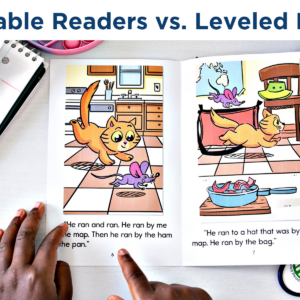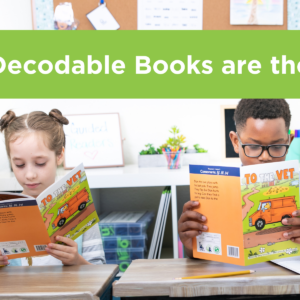Stop teaching high frequency words through memorization. It is a disservice to your young learners. We’re going to demystify the world of early literacy and tackle the controversial topic of high frequency words.
High frequency words are the words that kindergarteners, first graders, and even second graders will encounter most often. How we teach students these words can really set the stage for their lifelong relationship with reading.
While you may think that memorization is the best way to teach these words, it’s a huge mistake. I made this mistake in the past, and I want to help you avoid it.
Instead of using memorization, we should focus on teaching students the spelling patterns within the words to help them learn to decode the same way they decode other words. This method aligns with the Science of Reading (SoR) research and makes learning more engaging and, most importantly, effective.
Below are four strategies you can use to revolutionize how you teach high frequency words to young learners.
Four Strategies to Effectively Teach High Frequency Words
These strategies can be used with kindergarteners and first graders.
1. Organize High Frequency Words into Categories
There are 109 most common high frequency words that are crucial for students to learn very early on. I prefer that all kindergarten students learn these words because it can be instrumental in helping them learn how to read more quickly. 
It’s really important to organize these high frequency words by their sounds. For example, if you’re teaching the long “e” vowel sound, you could introduce the high frequency words: she, he, we. Or, if you’re focused on teaching diagraphs, you could introduce the words: this, that, then.
This strategy for teaching high frequency words is phenomenal. It helps students recognize high frequency words and reinforces the phonological patterns. Trust me, they will pick these words up faster and become sound detective superstars!
How to Group High Frequency Words
Above are the 109 high-frequency words grouped by similar skills. Focus on introducing the words in these groupings. While you may not have explicitly taught the skills yet, introducing the words by their commonalities can help anchor the words in the students’ schemas.
As you can see, we’ve organized the words by different concepts, sounds, or phoneme groups. The first column includes CV words like ‘an’ ‘at’ ‘as’ and ‘if’. The second column has CVC words, which also have some interesting pieces because we’ve got ‘find,’ ‘long,’ and ‘most’ that have blends at the end but are still considered CVC words. The reason why some words on the chart are red is because red words have irregular sounds and are always irregular.
Students likely won’t learn all the words the first time they’re introduced to them, but this approach can help students learn them faster than if they learn them in random groupings.
Based on research, students will learn high-frequency words quickly if they’re organized by skill, phonic sound, or syllable type. So, organizing high-frequency words is a great strategy for teaching them.
2. Use a Multi-Sensory Approach
Children learn best when they can see, touch, and hear, so why limit them to only the visual words? We want to provide students with a tactile learning experience by giving them different types of activities to help them learn high frequency words. Doing so provides a full bodied experience around the words.
 Here are some ideas of how you can include a multi-sensory approach in your high frequency word instruction:
Here are some ideas of how you can include a multi-sensory approach in your high frequency word instruction:
- Flour/sugar/salt bins: Place flour, sugar, or salt into deep Rubbermaid containers with lids). You can use five or six of these bins at your reading table. Students can use their fingers to spell words in the sand. When you’re done, you simply put the lid back on and put them away.
- Sandpaper letters: You can purchase these or use fine sandpaper to cut the letters out. Students can trace the letter with their fingers, which provides a tactile experience and helps build muscle memory.
- Tracing: Students can trace the letters using dry erase markers.
- Modeling Clay: Provide students with workmats showing the letters and have them shape the modeling clay to match the letters.
- Sky Writing: Students use their fingers to write the letters and words in the air.
- Arm Spelling: Have students use their hands to tap the letters for the word on their opposite arm.
While these activities take a little longer to complete in the classroom, they are great ways to teach students who need a more tactile approach. They’re also helpful for teaching the words students are struggling to master.
These are all examples of different types of kinesthetic and tactile experiences that students can use to really take hold of and master high frequency words.
3. Word Mapping
Phoneme-grapheme mapping is a game-changer in reading instruction. It’s all about breaking the words down into their individual sounds and then mapping those sounds to their corresponding letter or letter groups.
Word Mapping Example
Here’s a step-by-step guide for doing word mapping with your students. 
- Using a word mapping paddle, you’d have students tap out the sounds in the word.
- Have students slide up three discs representing the number of sounds in the word.
- Ask students what letter makes the first sound.
- Have students move the first disc up and write the letter in the box.
- Walk them through the same process with the remaining sounds.
- Have the students say the word a few times and give them an example of a simple sentence using the word.
Sometimes, while mapping words, you’ll come across sound and letter combinations that students haven’t learned yet. For example, the letter ‘a’ makes the schwa sound in the word ‘was’. You can give students a mini-lesson in the middle of your word mapping activity to introduce them to the schwa sound.
When you teach an irregular high frequency word, draw a heart under the letter on the mapping paddle. Then, explain to students that it is a heart word because it’s not regular, and the heart shows the part of the word that you have to learn by heart.
Mapping paddles make it easy to do phoneme-grapheme mapping as part of whole group instruction. Students can each have their own mapping paddle and set of magnet discs at their desks. You can map three to five words a day in less than five minutes, which makes it easy to fit into small gaps within the day.
If you don’t have mapping paddles, you can also do phoneme-grapheme mapping on a whiteboard. However you choose to do the activity, it will work and is a great way to teach high frequency words.
Phoneme-grapheme mapping supports orthographic mapping, which is the brain function for connecting letter chains in the brain. The brain connects phonemes to graphemes and links the word chain so students can automatically retrieve it when they’re reading. That’s why phoneme-grapheme mapping is such an effective way to teach high frequency words.
4. Incorporate Contextual Teaching
Words don’t live in isolation, so when we’re teaching high frequency words, we want to do more than just show students a flashcard with the word on it. Instead, we should use the words in sentences and stories and show them how they’re used in real-life situations.
 For example, as you teach students the high frequency word ‘the’, you could read them a story that includes the word multiple times. Ask students to point out the word when they see it. It’s like teaching them to point out a friend in a crowd. This helps the word stick because they’re seeing it in the natural habitat.
For example, as you teach students the high frequency word ‘the’, you could read them a story that includes the word multiple times. Ask students to point out the word when they see it. It’s like teaching them to point out a friend in a crowd. This helps the word stick because they’re seeing it in the natural habitat.
You could also have students dictate sentences to you that include the word ‘the’. This is a great way to practice the word if students are struggling. As the students dictate the sentences, you can write them down on the board or a piece of chart paper. Circle or underline the word in the sentence to help cement it in their heads.
I like using chart paper because you hang it up in the classrooms for the students to continue to reference as you move forward. You can take this a step further for the students by writing the name of the student who shared the sentence in parenthesis in a different color. Seeing their names next to these sentences helps the students take ownership of it. They love to see it, and it can help them feel proud of their work.
Using the words in sentences is an example of contextual teaching. You’re helping them to see the words and use them in stories. Write the words down for the students to see and practice using them in context.
This is also a great way of connecting words that many students in the class are having trouble with. There are always words that students can use more practice on, and teaching it contextually really helps them learn.
When you teach a word contextually, you don’t just use the word in isolation. You show them the word and how it functions in a sentence. This helps the students to begin to see the word as a useful tool and not just a chore to memorize.
Those are four game-changing strategies you can use to effectively teach high frequency words to your kindergarten and first grade students without relying on rote memorization. From using real-world context and stories to phoneme-grapheme mapping and categorizing words by their sounds, these approaches can revolutionize how you teach your students to learn high frequency words.







